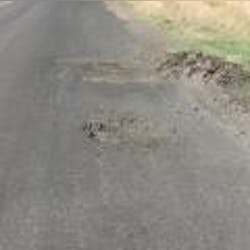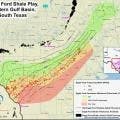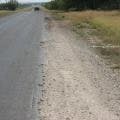Never meant to take the weight
In January of this year, the U.S. Energy Information Administration (EIA) issued a report stipulating that despite lower crude oil prices, production of crude oil is not expected to decline; to the contrary, it is expected to grow.
The agency is anticipating nationwide crude oil production to average 9.3 million barrels per day, an uptick of 700,000 barrels per day over 2014 returns. The resulting oversupply’s effect on at-the-pump gas prices can only be guessed at, but what does not require conjecture is the effect the energy extraction industry will continue to have on the nation’s transportation infrastructure, most notably the rural-level roads by which voluminous—and some might say outsized—truck traffic enables the companies comprising the industry to get materials into their sites and get their extracted product out and away for processing and eventual sale.
The notion of drawing a conclusion on a nationwide level in but a few pages of print is quixotic at best; therefore, this first of our three-part series, DOT in Crisis, will consider specific oil-heavy regions, how they have been facing this issue and what measures are being taken to assuage the growing damage to their roads infrastructure.
Whittling down the 1,000-ft view
Among the top producers of crude oil in the U.S. are Alaska, California, North Dakota and Oklahoma. But none are as oil-rich or as historically deeply connected to the oil and gas industry as Texas. Of the state’s 254 counties, nearly half are considered oil regions. Three major swathes of extraction are etched into the Lone Star state’s landscape: the Permian Basin in the west, the Barnett Shale Region to the east, and the Eagle Ford Shale Formation in the south. These regions have had a significant economic effect on the state for decades, none more so than the Eagle Ford, which after a $30 billion play development in 2013 has had a $60 billion economic effect on south Texas and has generated more than 115,000 jobs.
Rural roads throughout Texas, like these pictured from the Laredo District, are detriorating at a rate that has had alarming effects on roadway safety and economic development.
While the developmental and economic benefits of such efforts are not in question, their effect on the topographic infrastructure is only growing further and further querulous.
“Many of the roads were not designed to sustain heavy truck traffic,” Cesar Quiroga, senior research engineer with the Texas A&M Transportation Institute (TTI), told Roads & Bridges. “In south Texas, for example, there are many farm-to-market roads, which were designed to handle the occasional combine or 18-wheeler. But now you have a massive influx of heavy loads, and many of these roads have been destroyed pretty quickly.”
So, what does “pretty quickly” mean in practical terms?
According to Quiroga, it is a simple matter of calculable—and thus anticipatory—percentages. “When you look at the number of new horizontal wells in south Texas against the percentage of road miles that are considered below good, there is a strong correlation between the number of drills and pavement degradation. This relationship is not linear. If you double the weight of a vehicle, the impact on the pavement is not double; it is exponentially higher than that. A lot of people do not realize how critical this is. Worse, some of these trucks are not kept to a legal limit, which [in Texas] is 80,000 lb, with a by-permit overage of 5% to 84,000 lb. But since the impact is not linear, that ratio does not go up by 5%. It’s more like 25%. So, if you go up to 100,000 lb, which some of these trucks do, what do you get?” (See Figure 1)
The Eagle Ford Shale Formation cuts an enormous swathe through south Texas, aiding the economy but killing its small roads.
As all things related to commerce bear a price tag, it might come as no surprise to learn that the price tag affixed to this roads problem is a hefty one. “TTI came up with an estimate in 2012 of $2 billion per year just to take the roads back to their original condition,” said Quiroga. “This figure did not include interstate highways or bridges.”
The Texas Department of Transportation (TxDOT) stated in 2013 that it required more than $4 billion to maintain its roads network, to say little of expanding it. In a statement made to the Dallas Morning News in 2013, John Barton, TxDOT deputy executive director, said the development of a gas well in the Barnett Shale area causes truck traffic equivalent to 8 million cars, followed by a further 2 million cars per year for the life of the well.
In reaction to the accumulation of data culled by both TxDOT and agencies like TTI, a statewide Task Force on Texas’ Energy Sector Roadway Needs was formed, which concluded that widening and strengthening of rural roads in and around areas undergoing energy development was the most cost-effective solution to a foreseeable problem.
Yet, not half a year later, TxDOT announced plans to revert many south Texas roads to gravel—and why? Because “paving roads is too expensive and there is not enough funding to repave them all,” said TxDOT spokesman David Glessner. “Our only other option to make them safer is to turn them into gravel roads.”
Rural roads are, in essence, ineligible for federal funding, which means it is up to the states to squeeze the necessary dollars from their respective budgets. In 2014, Texans approved by referendum, known as Proposition 1, the use of billions of dollars from the state’s Rainy Day Fund for transportation needs. The amendment to the state constitution directed some $1.7 billion initially toward roads, with subsequent allotments beholden to oil and gas revenues. According to data issued by the American Petroleum Institute, Texas ranks 43rd in taxation on gasoline and diesel, while sustaining only the 44th-highest average per-gallon price.
In the face of a needed $4 billion annually, this measure, while progressive and in simple dollar value nearly absurd, doesn’t half cut it in terms of making sustainable progress on an ever-growing problem.
Dying by the fracking dozens
Hydraulic fracturing, or fracking, is the process by which high-pressure streams of water, chemicals and sand are injected into an underground rock formation to fracture the rock and release its oil and/or gas. In some respects, the external resources required to open and operate a fracking site outweigh what’s necessary to open and operate a standard drilling site.
“Hydraulic fracturing requires enormous amounts of water, which accounts for 60-70% of the truck loads in and out of this type of work site,” Quiroga said. “Water is by far the heaviest element of creating and operating these wells, but it is not pervasive. It has to be brought in from somewhere; so you analyze where the water sources are, and you can anticipate what will happen to the interceding roads.”
Such advance thinking is presently being put into practice by TTI’s Comprehensive Energy and Transportation Systems program, which attempts a holistic view of the transportation system in order to better develop manageable strategies. However, in order to make measurable strides in this way, it is necessary to address facts even more unfavorable than failing roads. Namely, how failing roads are leading directly to loss of life.
According to an investigation conducted jointly by the Houston Chronicle and Houston Business Media, there is a strong correlation between the fracking industry boom and the number of fatal roadway crashes in the state of Texas. In 2009, a reported 352 highway fatalities involved commercial vehicles; this number leapt to 532 in 2014, according to the report—a 51% increase. Simultaneously, the number of permits let for hydraulic fractioning increased exponentially. Moreover, according to the study, an average fracking site requires the operation of upwards of 400 tanker trucks, which are used to carry water and supplies to and from the site, making, in total, anywhere from 2,300 to 4,000 round trips. This figure, while jarring, pales in the light of TxDOT’s own estimation, made in a 2012 report by the Task Force on Texas’ Energy Sector Roadway Needs, that accounted for 1,184 trucks to get a site up and running, 353 to maintain yearly production and nearly 1,000 for refracturing every five years.
And how do they do that? By way of rural roads.
“In these areas, you have roads that were up to then very lightly maintained, but now have tremendous deficiencies and are being ground back into mud, basically, by this heavy truck traffic,” Rocky Moretti, director of research and policy for TRIP, and author of “Rural Connections: Challenges and Opportunities in America’s Heartland,” told Roads & Bridges. “It is, however, recognized [in these] areas that to support that kind of economic growth, what is needed is not only more capacity, but road surfaces designed to accommodate these heavy, high-volume vehicles. In fairly rural areas, you used to see some agricultural vehicles, but then all of the sudden energy extraction goes through the roof and the state of Texas is looking at $2 billion per year just to keep up.”
According to the TRIP report, rural roads nationwide have fatality rates three times higher than that of all other roads, a startling figure given the fact that rural and non-interstate routes account for fully 25% of all vehicle-miles travelled in the U.S. each year. Moreover, the average travel per-lane mile by large trucks on non-arterial rural roads in the U.S. increased 16% from 2000 to 2012, at the same time that nationwide production of liquid fuels, including crude oil and natural gas, increased 34%. This figure represents approximately 47-54% of all U.S. energy production. And it’s not going down anytime soon.
What does this mean specifically in the case of Texas? According to the TRIP report, Texas had the highest number of non-interstate traffic deaths in 2012, with 1,509, corresponding to an average of 2.76 deaths per 100 million miles of travel. In comparison, the state averages 1.03 deaths per 100 million miles travelled on all other roads. Rural roads are more likely to feature narrow lanes, limited shoulders, sharp curves, exposed hazards, drop-offs in the pavement and limited roadside clear zones. Tack onto those facts pulverized matting and pervasive cracks and crumbling, and the question of maintenance versus reconstruction becomes even murkier.
Despite funding challenges, which are universally acknowledged, Moretti sees the situation as fairly cut and dry. “The bottom line is, when you improve road safety, the number of crashes and fatalities goes down. States needs to look systematically at safety, at what it would take to increase safety on [their] entire system.”
While the straits associated with funding major infrastructure on a statewide basis remain on par to some degree with moving a mountain, progress is being made. Through the TxDOT Maintenance Division, TTI has begun working on an interagency agreement by which TTI collects and synthesizes data to aid TxDOT in “understanding the magnitude of damage to [its] pavement structures.”
Quiroga said, “An [associated] practice is to understand what practices TxDOT performs to sustain roads. Different districts have different practices. TTI recommends what practices we see as being better, and we help disseminate that information. We also provide criteria for designing better roads, particularly in conjunction with oil and gas developments. In the Permian Basin, for example, the roads are getting better because since there has been such a long history of heavy traffic connected to drilling, roads are being better planned for.” In other words, strides are being made, if modestly, to get ahead of the problem.
Accountability in the East
Pennsylvania is not far behind Texas in terms of what effect rural road degradation is having on safety and drivability. In 2012, 636 non-interstate traffic deaths occurred, an average of 2.60 deaths per 100 million miles driven. According to TRIP, 17% of the state’s rural roads are considered “poor” and one-quarter of its bridges structurally deficient, a whopping 13% above the national average.
The Pennsylvania rural road network is comprised of more than 151,000 lane-miles and 14,638 bridges, which are largely the responsibility of the state’s 2,576 local municipalities. What this means is that trying to keep up with the degrading state of rural and two-lane municipal-level roads is a rather daunting endeavor.
“PennDOT cares that its roads are safe and passable,” Jason Synder, principal engineer with URS Corp, told Roads & Bridges. “Past that, it’s up to the engineer to maintain the road. If I spend a million dollars patching a stretch of road today at 9 a.m., I will spend another million next week, and the week after, and so on. But if I fix the road correctly on day one, I’m not going to have a problem next week, or for the next 16 years, if I’ve done it correctly. It’s all about time, value and money.”
The accumulation of energy extraction traffic rolled into Pennsylvania with significance in 2010 and has only continued to expand. (In 2014, 4,450 permits for drilling and/or fracking were approved.) What it rolled into, however, was a hard line on problematic infrastructure resulting from industrial road use.
“In 2010 is when it largely began,” Synder said. “They came in from Texas and Oklahoma and did business as usual. Then the roads started to fall apart, because they did not understand the makeup of our roads. Well, the Commonwealth held them responsible for that. Just as in North Dakota or West Virginia, you can’t pass a posted road without taking legal responsibility for it. [Editor’s Note: Most roads in northern and western Pennsylvania are posted at 10 tons.] If you damage it, you pay for it. The Commonwealth holds [these companies] responsible for that.”
So it was in 2010—and so it remains today.
John Voda of Chesapeake Energy, one of the state’s largest extraction operators, told Roads & Bridges, “We have an access maintenance agreement with the Commonwealth. Damage caused by company traffic is the company’s responsibility, and we’re not the only one with such an agreement. The idea is to get ahead of the problems not as they occur but before they occur.”
“Companies will now upgrade roads in advance of destruction,” said Synder. “The Commonwealth does not look favorably upon companies that destroy roads and then want to patch them up. It’s just not safe.” Synder estimated that his company, which has a long-standing relationship with PennDOT and the principal oil and gas companies, including Chesapeake and Shell, has alone built more than 500 miles of two-lane roadway in the state, as well as in West Virginia and Ohio, since 2010. “These companies have spent hundreds of millions fixing roads. What we would do is, when a company posts a bond to use a road, we’ll take what’s usually 2 in. of paving on a few inches of stone on glacial till, and transform it using full-depth reclamation to 15 in. with 7 in. of asphalt, expressly to withstand the truck traffic [from the site]. You’re basically ending up with interstates through rural Pennsylvania.” (For more on FDR in Pennsylvania, see “Taking down a trampoline” in our February 2015 issue.)
Many rural roads throughout the U.S. were designed to withstand what is called farm-to-market traffic, meaning regular vehicles and the occasional combine. Now they are dealing with trucks so heavy, their impact is equivocal to millions of regular-size vehicles.
Bolstered by extraction taxes, which are dispersed throughout all municipalities affected by oil and gas drilling or fracturing to supplement their revenue, the state enacted a gas tax to aid PennDOT and the municipalities for increased roadway maintenance costs.
The measure of success here is palpable, according to Snyder. The difference between Pennsylvania and Texas is not merely a matter of dollars, or of time, but of vestment and accountability. The stringent regulations imposed by the Commonwealth simply do not tolerate the activity that is tolerated in the Lone Star state.
So, what now?
It seems fairly clear that federal legislators, while eager to pontificate their allegiance to progress, care more for the political aspects of their agenda and less for the legislative ones they are primarily tasked with pursuing. That dance looks to continue well into the crucial weeks leading up to the depletion of the Highway Trust Fund, despite a number of proposed plans and many vaunted declarations from our national leadership. Pursuant to the idea that tough problems require tough solutions and that the U.S. has always been peopled by those ready and willing to pay their own way, the aspect of the future of rural transportation that is absolutely key to progress is the fact that it is never just about a road.
“Everything is connected,” Quiroga recently stated. “We need to identify needs where better practices can result in more sustainable developments and more effective management of the transportation infrastructure.” R&B



